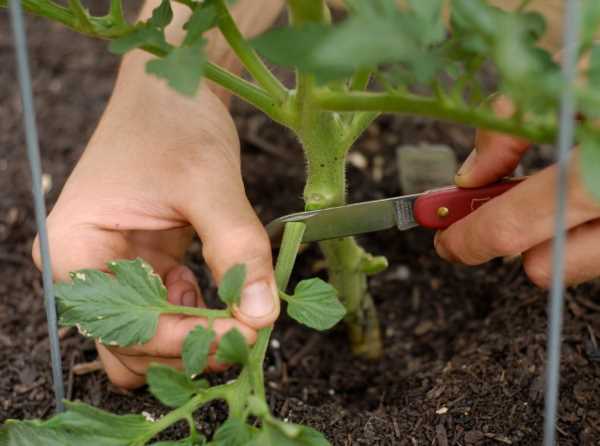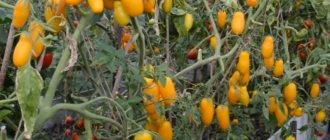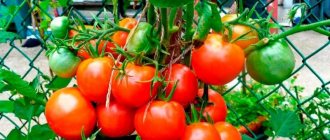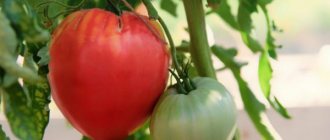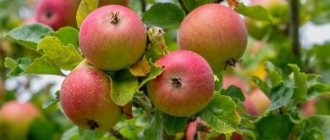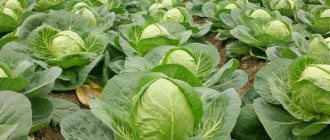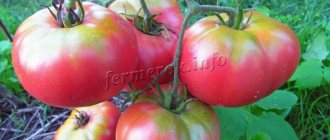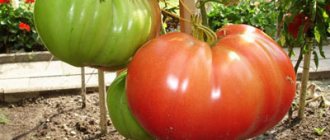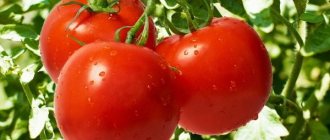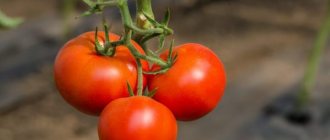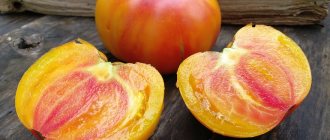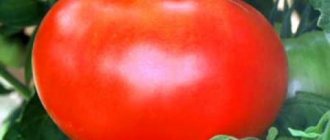Description of the tomato variety Grushovka, reviews, photos
Mid-season (111-115 days from germination to the beginning of ripening), determinant, high-yielding variety of Siberian tomato for open ground and film shelters.
Standard bush, 0.5-0.7 meters high, does not require pinching. A garter to the support is desirable, since the bush can collapse under the weight of the fruit.
The leaf of this tomato is medium in size, dark green. The inflorescence is intermediate.
Fruit characteristics
Fruits - elongated cream, slightly widened downwards, at the stage of ripeness, raspberry-pink color, weighing 90-120 grams, good tomato (sour) taste. They have good keeping quality, not prone to cracking. These tomatoes are universal in purpose - ideal for whole-fruit canning, they are also suitable for salads and processing into tomato products.
The variety is included in the State Register of Breeding Achievements of the Russian Federation Pink pear.
Reviews of gardeners
Valentina, Novosibirsk
Seeds from the SibSad firm. Plant up to a meter, compact. Mid-season, pink fruiting. Tastes: +) with sweetness, fleshy. Fruit weight from 100 to 135 gr. Does not stretch in seedlings.
Olga, Saratov
Fruits are dense, well stored, do not crack under adverse weather conditions. Tastes good, canned it. FF does not get sick after double treatment with HOM.
Features of growing, planting and care
Sowing the seeds of this variety of tomatoes for seedlings is carried out 60-65 days before the intended planting in the ground. Dive - at the stage of two true leaves. When planting seedlings to a permanent place of 1 sq. m of the site is recommended to place up to 6 plants. Landing scheme: 70 x 30 - 40 cm.
Further care for tomatoes consists of timely watering, removing weeds, dressing and preventive measures to protect the crop from diseases and pests.
If you have grown Grushovka tomatoes, please write whether you like them or not. What was the yield and taste of the fruit in your climatic conditions? Will you grow this strain again and recommend it to others? If possible, attach a photo of the entire bush or individual fruits that you have grown. Thank you!
Your reviews about the Grushovka tomato, as well as additions to the description, will help many gardeners evaluate this variety objectively and decide whether it is worth planting it or not.
A selection of reviews from amateur gardeners
Tomato Grushovka is actively planted by residents of Siberia, the Urals, the Far East. The variety normally takes root and bears fruit in the harsh conditions of these regions. Galina from the Novosibirsk region. notes the compactness of plants. The gardener gets a good harvest from a small greenhouse area.
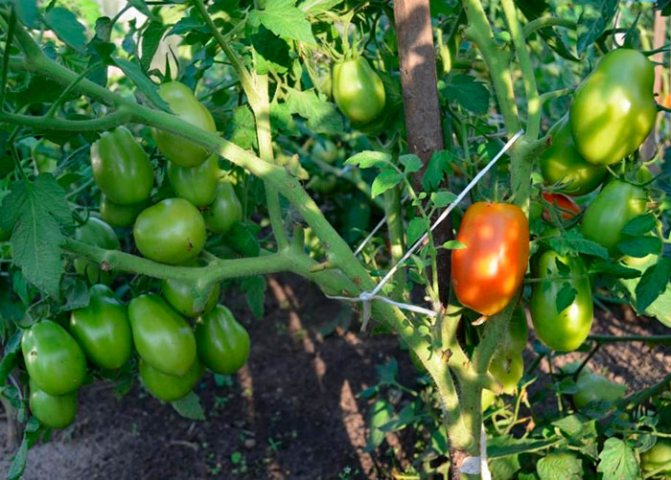
Lyudmila from Krasnoyarsk, in her review, noted the taste of the fruit. They are especially good in salting. The firm skin prevents the tomato from cracking. This is an additional plus of canning pear-shaped tomatoes. Valentina (Khakassia) noted the immunity of culture.
On thematic forums, gardeners participate in debates about several varieties, popularly called Grushevka. The most common varieties are from well-known vegetable breeders Nikolai Egorov and Nikolai Alexandrov. Their cultures are similar to each other. Only in the first, the fruits are slightly smaller, and in the second, the bushes are lower.
The variety of pear-shaped tomatoes has proven itself from the best side over the years of cultivation. With a little care, the tomato demonstrates a decent yield and pleases the owners of the garden.
Description of the tomato variety Grushovka
In order to choose the tomatoes that are ideal for you, you should plant the most interesting and liked according to the description. One of the wonderful high-yielding varieties with versatile fruits of a very unusual shape is the Grushovka tomato. Moskovskaya Grushovka tomatoes were bred about 20 years ago in Russia, as a result of long-term Siberian breeding. During all this time, they show excellent productivity indicators, and the care is almost the same as most other varieties.
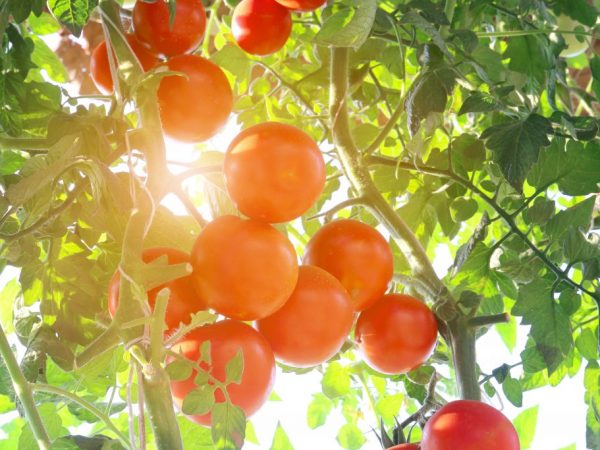

Description of the tomato variety Grushovka
Top dressing
If the soil on the site is not fertile, then it is recommended to apply mineral and organic fertilizers.
- The first feeding is carried out 7-10 days after planting. You can use different mixtures. A tablespoon of nitrophoska and half a liter of liquid manure or a tablespoon of the factory fertilizer "Ideal" are diluted in 10 liters of water. Half a liter of solution is poured under the tomato bush Grushovka.
- During the flowering period, a solution is used: 0.5 liters of chicken manure, a tablespoon of superphosphate and a teaspoon of potassium sulfate are added to 10 liters of water. The mixture is thoroughly stirred and poured into a liter of solution under each bush.
- When the Grushovka tomatoes begin to ripen, it is necessary to use fertilizers containing boron, iodine, manganese, potassium. These elements will provide a high yield of juicy and fleshy Grushovka tomatoes. To prepare top dressing, take 10 liters of water, 10 g of boric acid (in powder), 10 ml of iodine, 1.5 liters of ash (well sifted). The mixture is gently stirred and poured under a bush by a liter.
Advice! Only boiling water is used to dissolve boric acid. The powder is diluted in a small amount of water, and then added to the total mixture.
To accelerate the setting and ripening of tomatoes of the Grushovka variety, foliar feeding is carried out. To do this, dilute 50 g of superphosphate in 10 liters of hot water. The solution must stand for a day and then each bush is sprayed with 10 ml of the composition.
It is better to make any kind of dressing in dry weather in the morning or evening. The best option is to combine this procedure with watering tomatoes. You can alternate different ways of feeding Grushovka tomatoes.
Important! In order not to be mistaken with fertilizers, one must bear in mind: nitrogen mixtures are applied in the spring, since they ensure the growth of green mass, and phosphorus and potash are added during the growing season and in autumn.
Characteristic of Grushovka
Tomato Grushovka is a determinant, productive and mid-season variety (110-115 days before the start of fruiting). It should be borne in mind that ripening times vary depending on the region, on climatic conditions and on the various subspecies of this variety. The variety is considered the most suitable for the Kirov region of Russia. There, on vegetable farms, tomatoes are most often grown Grushovka, the official description says that such a crop is the most profitable choice for the commercial cultivation of tomatoes.
The Grushovka tomato variety has two varieties:
- Japanese (in our country, it has not acquired distribution).
- Moscow (grown everywhere).
These tomatoes are intended for cultivation in the following conditions:
- open ground (the height of the bushes is 50-60 cm);
- greenhouse (height reaches a meter and more);
- under the film.
Description of culture
The plant forms compact bushes, its leaves are medium in size, dark green in color; inflorescences are intermediate. 5-6 fruits of the same size grow on one cluster. Ripening is uniform.
The peculiarity of the Grushovka tomato is a unique characteristic of the appearance of the fruit, which is their distinctive feature.The fruits of these tomatoes are of a characteristic elongated shape, wider at the bottom, resembling a pear or pepper, which gave the name to the variety. The green pear tomato in the photo looks like a ripe fruit, not a vegetable. Weight is 90-120 g, some fruits reach 250 g. Tomatoes have a very pleasant aroma, red or bright pink color, and an excellent taste with a slight sourness. The pulp is fleshy, pink, juicy, the seed content is low. They keep well and are not prone to cracking. Long-term preservation of presentation and taste during transportation makes this variety one of the leaders among tomatoes.
Why is there no fruit
- Seed infection. Be sure to process from a solution of potassium permanganate before sowing.
- Temperature over 30 with ovary formation. This can cause the pollen to become sterilized.
With proper care and compliance with all the requirements of agricultural technology, many delicious fruits can be harvested from 1 bush. Pear tomatoes may vary slightly in color, but their shape and size always remain the same.
Tomatoes weigh 100 g, and some specimens weigh 150 g. They have a sweetish taste, where sourness is clearly felt. The fruits grow neat and uniform. They are very dense, therefore they are perfectly preserved in a jar when salted or pickled.
This tomato is considered one of the leaders when it comes to canning. But even fresh, they are very good. Tomatoes can be stored for a long time, so the hostess will have a base for a vegetable salad throughout the summer. Regardless of the color of the fruit, taste and other characteristics will be the same.
Valeria, Moscow region: “I always plant Grushovka in large quantities, as it is my favorite variety for canning. Fruit jars always come out reliable and very beautiful. Nothing bursts or deteriorates for a long time. "
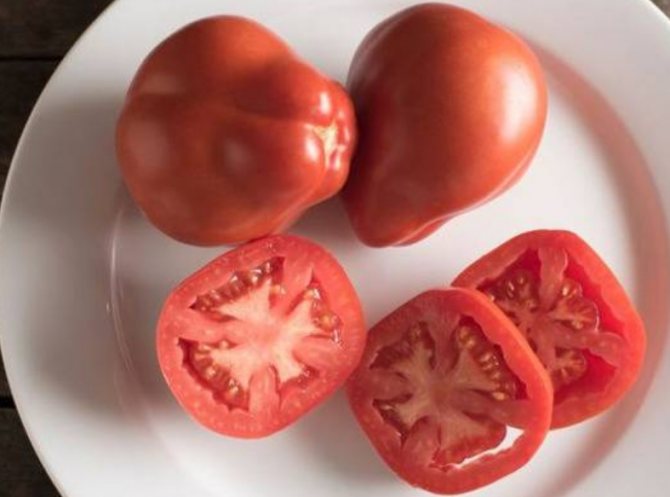

Margarita Stepanovna, Yuzhnouralsk: “An excellent variety, which is well suited even for our regions. Usually she planted the Khabarovsk type, and never had any problems with growing. These tomatoes are more resistant to weather conditions, and the harvest is good under any conditions! "
Features of growing and care
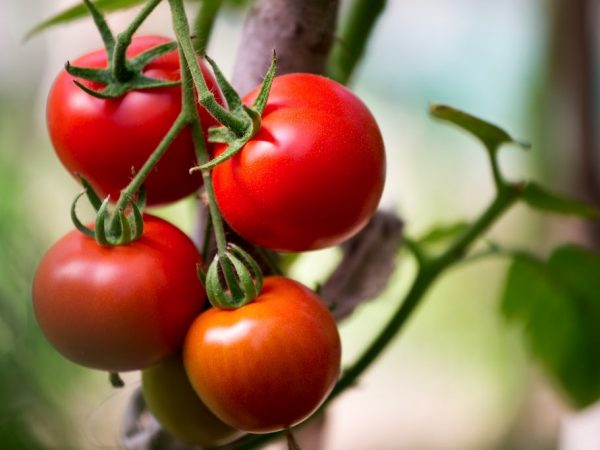

Proper care will ensure a good harvest
Before planting Grushovka tomatoes, it is recommended to feed the soil with nitrogen-containing fertilizers. Reviews of experienced gardeners recommend fertilizing the area in the fall where you plan to plant tomatoes next year by digging up the ground with the addition of roots and leaves of lupine containing nitrogen. Breeders advise growing Pears in the traditional way, using seedlings.
Caring for tomatoes Moskovskaya Grushovka includes the following:
- picking;
- watering;
- pinching;
- tying to supports;
- loosening;
- top dressing;
- weeding and weeding;
- protection against diseases and pests.
Growing seedlings
Before sowing, the seeds must be processed by placing them for 25-30 minutes in a weak solution of potassium permanganate (5-8 g of potassium permanganate per liter of water). Zircon solution can be a good alternative to potassium permanganate. As an additional treatment, a growth stimulator can be used, due to which germination is significantly increased. Then the seeds are washed in clean water and dried a little. You can germinate them by wrapping them in damp gauze for 1-2 days. Seeds are planted to a depth of 2 cm, maintaining a small distance between them so that the sprouts do not stretch out.
When germinating seeds, the substrate should be fed with a complex fertilizer, or wood ash should be added in an amount of 100-150 g per square meter.
Further fertilization should be done every 14-20 days. For feeding, apply:
- broad spectrum chemicals;
- organic fertilizers (manure, humus);
- traditional biological methods (tops of lupine, other plants).
However, in order to reduce the harmfulness of chemical fertilizers, it is quite possible to replace them with biological ones, which will also allow you to grow an excellent harvest of Grushovka.
Seedling care
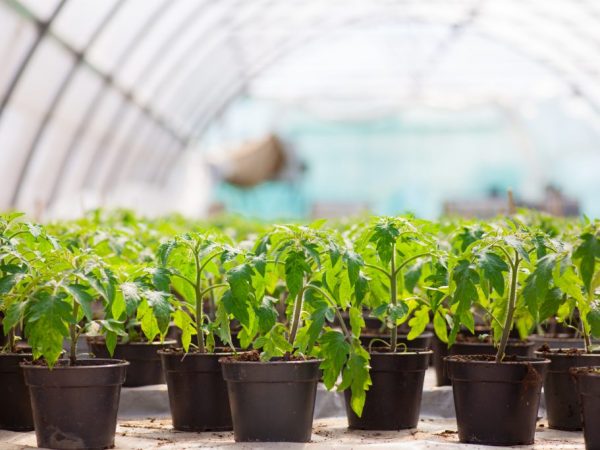

Seedlings must be hardened
Young shoots must be planted and at the same time picking, in the phase of 2-3 leaves, which stimulates the development and rapid growth of the root system of plants. 2 weeks before planting in open ground, the seedlings need to be hardened, starting at half an hour in the air, and then leaving the plants for the whole day before planting.
Seedlings are ready for planting directly into the ground at the age of 45-55 days. When the danger of night frosts has passed, and the soil warms up to 15 degrees, you can plant seedlings on the site. No more than 5 plants are located on one square meter. It is recommended to maintain a distance between seedlings in a row of 30-40 cm, and between rows - 70 cm. When watering, care must be taken using warm water. It should be watered gently at the root so that water does not fall on the leaves. It is best to plant tomatoes at sunset or in cloudy weather so that the tender sprouts do not burn in the sun.
Immediately after planting the seedlings in the ground, it is advisable to install supports for the sprouts and tie the plants to them. You should also carry out pinching in order to properly form the bushes. The ideal option, which ultimately gives a very high yield and large fruits, is the formation of a bush consisting of 3-4 stems.
Growing seedlings from seeds
A particularly high-quality crop can be obtained by growing it on well-fertilized soil... When choosing a site, it is necessary to take into account the fact that windy areas will badly affect the development of the plant, it is better to give preference to the sunny side.
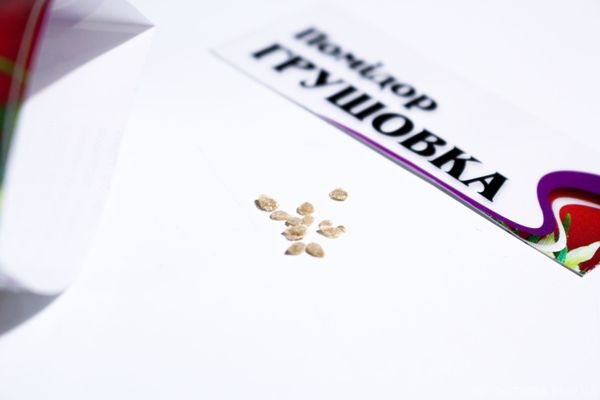

Tomato seeds Grushovka
- Experienced gardeners do not recommend sowing seeds for seedlings earlier than 1.5-2 months before the intended planting in open ground. It is recommended to grow seedlings in a greenhouse or a regular room, using pots and boxes for sowing seeds.
- Conduct a thorough seed preparation: conduct disinfection of seeds in a light solution of potassium permanganateand then germinate them in a humid environment.
- When planting seeds, observe the planting depth in 2-3 cm... Otherwise, the shoots may be weak. When the first leaves appear, it is worth carrying out the first feeding of the seedlings. Purchased complexes or ash can be used as fertilizer (no more than 120 grams per sq. M.)
- After the appearance of 3 leaves on young seedlings, pick and plant.
Seedlings can only be planted after they are fully grown. It is better to gradually acclimatize the plant to new conditions.
Landing in open ground is carried out only after the ground has warmed up up to 14-16 degrees... To plant on a square meter no more than 5 bushes... In order for the tomatoes to grow stronger and grow faster, it is better to take care of organic soil dressing in the fall: dry roots, leaves, ash.
Protecting Pears from disease
Unfortunately, the tomato variety in question does not show sufficient resistance to diseases and pests, and therefore requires special attention.
Diseases of Moscow Grushovka:
Macrosporiasis (or brown spot)
This disease is triggered by fungi that affect the stem and leaves. High humidity only contributes to the rapid development of fungi. The best way to fight is antifungal solutions that include copper (Barrier).
Viral mosaic
Leaves, stem and fruit are covered with spots resembling marble. In this case, the only way out is to destroy the affected plants. The soil around the roots of a diseased plant should also be removed. Only this way can stop the spread of the disease to other bushes.
Top rot
Only tomatoes are susceptible to this disease.The fruits of the diseased plant are covered with brown spots and dents on the tops. Top rot is most susceptible to damage to tomatoes growing on soil poor in calcium.
Lack of food
To get, as in the photo, a tomato Grushovka, it is necessary to prevent diseases, treat pests, and also make top dressing.
With a shortage or excess of nutrients, the color of the leaves and their shape change. It can also affect the quality of the fruits, their appearance, taste.
- Lack of phosphorus is manifested by a change in the color of the foliage. It turns purple. The veins begin to dry and acquire a deep purple hue.
- Yellowing of leaves, small size indicate a lack of nitrogen.
- Pale yellow tops, dry foliage are symptoms of iron deficiency.
In addition, the tomato may develop macrosporiosis, viral mosaic, and apical rot.
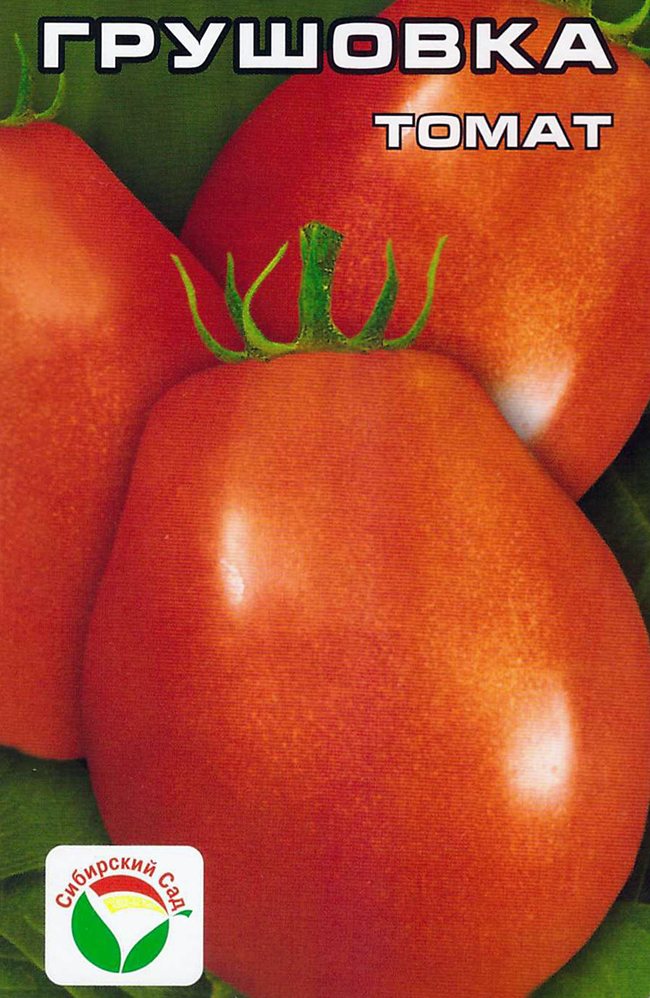

Description of tomato Grushovka and its characteristics
The Grushovka tomato varieties were bred by Siberian breeders in the late 90s of the last century - in the early 2000s. The countries were entered into the State Register in 2001. There are several types of Pears, these are:
- Moscow Grushovka;
- Khabarovskaya Grushovka;
- Pink pear;
- Red pear;
- The pear is yellow.
All these species are characterized by high yields, unpretentious cultivation and care, as well as early ripening. They differ in color, shape, size and cultivation region. Suitable for growing both open and greenhouse.
What is a plant
The bushes are characterized by compactness and short stature:
- their growth does not reach a height of more than 60-65 cm;
- the central stem is thick and strong, however, in order to avoid breakage from the severity of the crop, it is advisable to tie up the bushes;
- leaves, medium in size, strongly pubescent, have a dark green color;
- the bush practically does not form stepchildren, therefore it does not require pinching. It is only necessary to cut off the lower leaves as the bush grows;
- plants are determinant. They stop their growth when 5-7 brushes are formed on the bush, on each of which 5-6 tomatoes ripen;
- plants need to be helped with pollination - shake slightly during flowering. It is worth knowing that the process of pollination can be impeded by high humidity in the greenhouse;
- in the open field, pollination occurs naturally, and fruit setting does not depend on weather conditions.
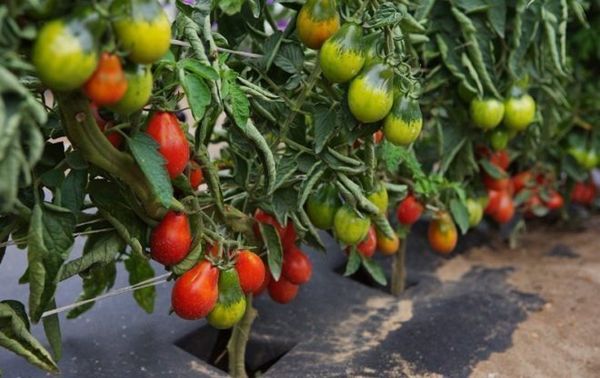

Appearance and taste of fruits
Grushovka tomatoes are very attractive in appearance:
- the weight of fruits ranges from 100 to 150 g. There are some specimens, the weight of which reaches 250 g;
- the shape of the tomatoes is unusual, pear-shaped (wide base and narrow top). The shape of Khabarovskaya Grushovka resembles pepper. The surface of the fruit is smooth and shiny;
- the color depends on the variety. It happens in deep red, raspberry pink or yellow-orange;
- juicy, fleshy and very fragrant pulp is covered with a thin but dense skin, which is not felt at all when eating;
- the taste of the fruit is excellent, sweet with a slight sourness.
100 g of tomato pulp contains:
- carbohydrates - about 5 g;
- proteins - 1.2 g;
- fat - 0.3 g;
- water - not less than 93 g;
- fiber - 0.8 g;
- organic acids - 0.5 g;
- pectin - 0.3 g;
- ash - 0.5 g.
Energy value 100 g - only 23 kcal.
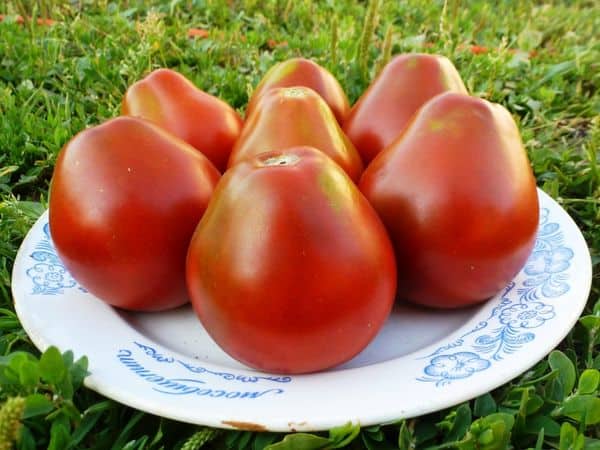

Application
In addition to the fact that the fruits of Grushovka have a great taste and are eaten fresh, they produce excellent tomato juice, tomatoes in their own juice, both pureed and whole and cut into pieces, high-quality tomato paste, as well as various ketchups. Preparations for the winter are made from the fruits of the hybrid - pickled tomatoes, assorted varieties, various marinades, salads and snacks. They are added to various meat and vegetable dishes, as well as to pizza and shawarma.
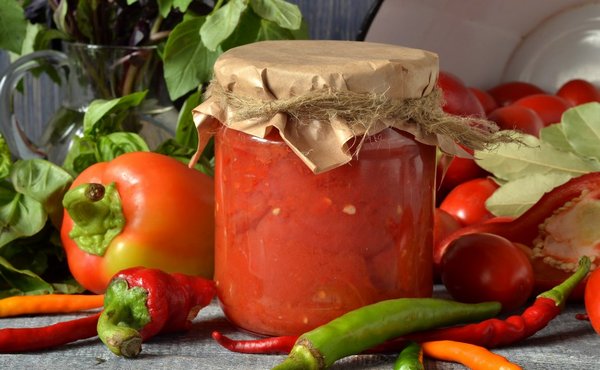

When it starts to ripen
Pear is a hybrid of mid-early ripening.Its vegetation period is 110-115 days from the moment the first shoots appear. The first fruits begin to set in early July. Brushes with ovaries appear one after another on the bushes. There is also a ripening process. The fruits are harvested as they ripen.
Yield indicator
The pear tree has a stable high yield. With good care, 5-6 kg of a tomato are removed from one plant, and a little more than 9 kg from one square meter.
Attitude to weather conditions and growing regions
This type of tomato is characterized by high cold resistance. It tolerates sudden temperature changes and hot weather. In case of heat and drought, additional watering is required. Excessive humidity and cloudy weather can cause fungal diseases as well as fruit setting problems.
This hybrid is cultivated throughout our country. In the southern regions and in the Middle Lane, it is grown in the open ground, and in the more northern regions - in the North-West, in Siberia and in the Urals - by the greenhouse method. The ripening of fruits is not affected by weather conditions.
Harvesting and storing the tomato crop
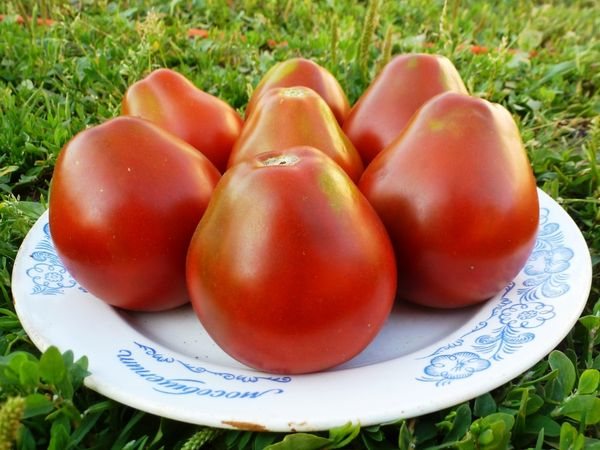

Healthy tomato fruits must be picked separately from spoiled ones.
- Healthy and firm fruits must be picked separately from spoiled ones.
- To lay down stalks up, in small boxes. It is better to put paper on the bottom.
- Save fruit boxes in a dark, cool place... High humidity in the storage room is recommended.
- It is advisable that the last stage of ripening is carried out not on a bush, but in a box. The best storage temperature is not higher than 10-12 degrees... So there is a chance to feast on fresh tomatoes for 2.5 months.
The variety remains a favorite for many gardeners. In order to get a good harvest, you only need to adhere to the elementary rules for the care and storage of tomatoes.
Diseases and pests
Pears does not have good immunity to a number of diseases and can be affected by:
- top rot, the reasons for the appearance of which can be many - from improper soil acidity to illiterate care of bushes. To prevent disease, the seeds must be kept in a weak solution of potassium permanganate for several minutes before planting. It is also necessary to observe the required temperature regime and the required humidity in the greenhouse. Do not loosen the soil around the bushes too much. This can damage the roots. If the disease appears, then the affected fruits must be destroyed, and the plants must be treated with an aqueous solution of calcium chloride (for 10 liters of water - 40 g of the drug);
- macrosporiosis, caused by sudden changes in temperature, from which the fungus begins to multiply. Symptoms are rounded dark spots on the leaves, petioles and fruits, which merge over time, and parts of the plants dry out and fall off. Prevention - choosing healthy seeds, disinfecting them and the soil before planting, cleaning the greenhouse from weeds and organic debris, processing seedlings and affected bushes with a 1% solution of Bordeaux liquid;
- viral mosaic. Symptoms are the appearance of yellow spots on the leaves with a bright border, as well as deformation of the fruits. At the first sign, the bushes are treated with a solution prepared from 10 liters of water, a liter of milk and 10 drops of iodine, as well as Lamador and Maxim fungicides.
Top rot of tomatoes.
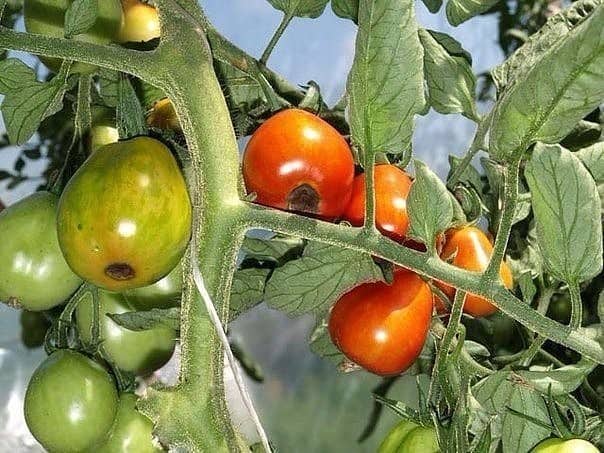

As a preventive measure, bushes must be treated against insect pests, such as aphids, spider mites, slugs, whiteflies, etc. For this, appropriate insecticides are used.
Bush care
Grushovka belongs to unpretentious tomatoes. But the basic requirements for care must be observed: watering in a timely manner, but not allowing the soil to become waterlogged. Otherwise, the plant will start to hurt.
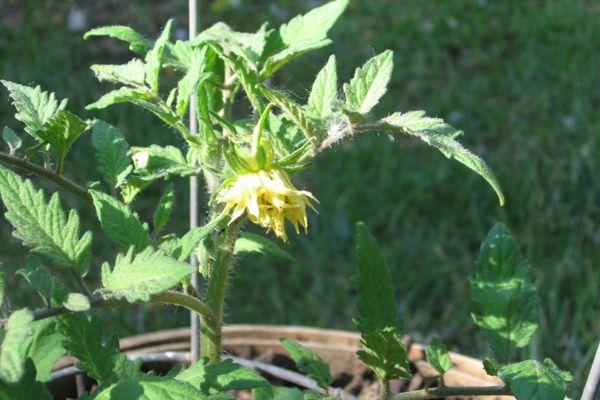

A pear of any kind is considered resistant to most diseases. Without observing the basic rules for caring, the bushes will suffer from macrosporiosis or various types of rot.The latter type of the disease most often occurs in tomatoes that grow in a greenhouse.
Pros and cons of a hybrid
With a minimum number of disadvantages, and this is vulnerability to diseases and pests, the hybrid has a huge number of advantages. Grushovka is characterized by:
- compact bushes that do not require pinching;
- high yield;
- early ripening;
- sizes suitable for canning;
- excellent taste of tomatoes and their excellent presentation;
- long shelf life and the ability to transport over long distances;
- ripening of fruits in any weather.
Advantages and disadvantages of the variety
Pros:
- Good fruit preservation is precisely the feature that pleases most lovers of this tomato variety. Tomato skins do not crack or burst, making them ideal for preservation. Delicious tomato juice turns out;
- The Moscow pear tomato is a low-growing variety that does not require pinching. It is only necessary to tie up the bushes. However, many gardeners note that they can do without even this procedure;
- This variety has good resistance to weather conditions;
- Compared to other varieties of tomatoes, it is less susceptible to diseases;
- High productivity.
As a disadvantage, it can be noted that Grushevka is a variety of tomatoes that are demanding on moisture. It is necessary to carefully monitor the condition of the soil.
Growing tomatoes often causes big problems for summer residents. However, the Grushovka tomato is a variety loved by many gardeners, due to its unpretentiousness and incredibly tasty fleshy fruits, which are always in abundance.
In addition, the "pear" variety of tomatoes is ideal not only for large farms, but also for small summer cottages. Recently Grushovka is gaining more and more popularity.
As a disadvantage, it can be noted that Grushevka is a variety of tomatoes that are demanding on moisture. It is necessary to carefully monitor the condition of the soil.
Pros:
- productivity;
- commercial properties;
- keeping quality and transportability;
- excellent taste characteristics;
- endurance of adverse factors;
- ease of cultivation.
Minuses:
- poor resistance to pathogens.
Pros:
- productivity;
- commercial properties;
- keeping quality and transportability;
- excellent taste characteristics;
- endurance of adverse factors;
- ease of cultivation.
Minuses:
- poor resistance to pathogens.
How to grow
Grushovka, like other varieties of tomatoes, is grown by the seedling method. The quality of the further harvest depends entirely on the quality of the seedlings.
Growing seedlings
Growing seedlings is not difficult at all. You just need to observe the following rules:
- before sowing, the seeds are soaked for 30 minutes in a light pink solution of potassium permanganate, then dried in the open air;
- soil for seedlings bought in a store or prepared independently is poured into containers or immediately in separate pots, slightly moistened with water from a sprayer and sowing seeds at a distance of 3 cm from each other, slightly pressing into the soil;
- the container is covered with a film and removed to a warm, dark place until the first shoots appear;
- as soon as the sprouts have appeared, the film is removed, and the containers or pots are placed on a light windowsill;
- after the appearance of the third leaf, the seedlings dive if the seeds are sown in containers;
- seedlings need care - watering, feeding and hardening, which is carried out 10 days before planting the seedlings at a permanent place of growth.
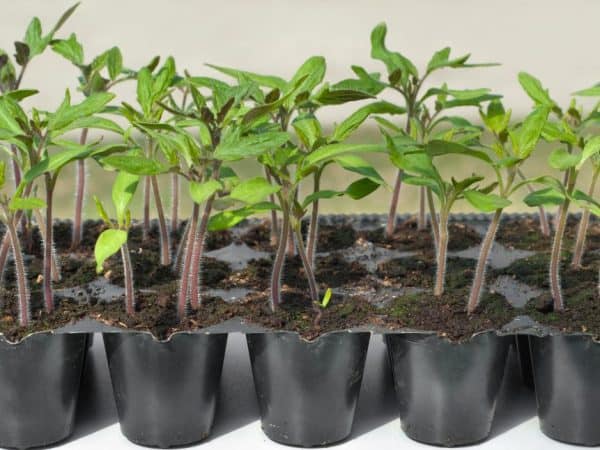

Landing
Seedlings are planted in the greenhouse in early May, and in open ground in early June. The soil is prepared in advance - dug up, cleaned of weeds, fertilized.Next, holes are made at a distance of 30-40 cm from each other and seedlings are planted in them, after adding a handful of ash, humus and 0.5 liters of water there.
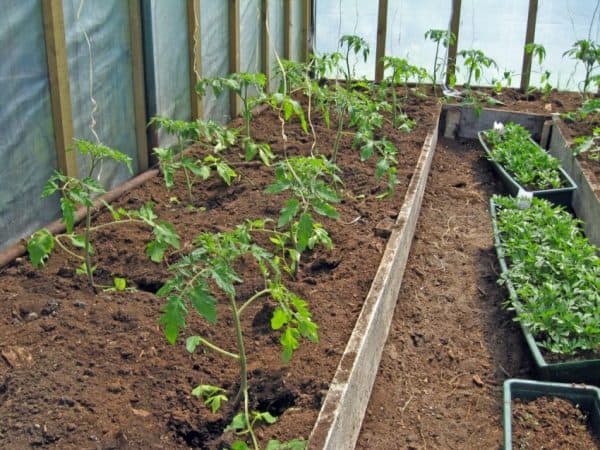

Taking care of Grushovka is simple:
- it is necessary to water the tomatoes every 7 days;
- loosen and weed the soil around the bushes;
- feed once every 2 weeks;
- tear off the lower leaves as the bush grows;
- tie the bush to the support.
